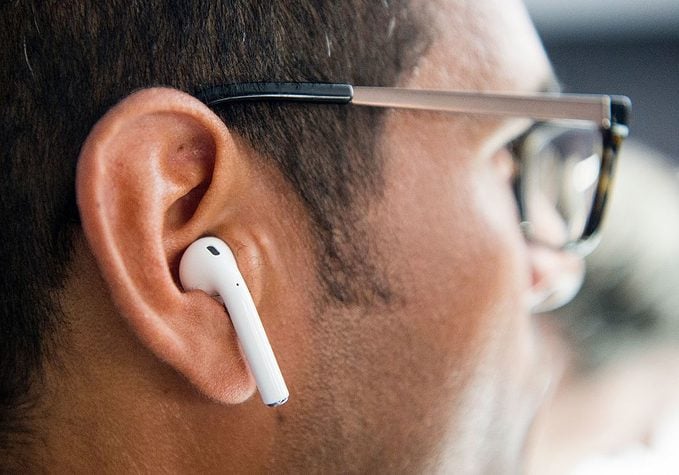If you use your iPad or iPhone with headphones, then Apple's Sound Recognition feature is a must. Read on to see what Sound Recognition is, what it does and how you can enable it on your device.

If You Wear Airpods, You Need to Know About This Hidden Feature

Headphones are great for enjoying music, podcasts and audiobooks in peace, allowing you to block out distracting noise. The other side of that coin is that headphones, and especially noise-canceling headphones, make it easy to miss important sounds like doorbells, alarms or a child who needs attention. Thankfully, if you’re an iOS user, then there’s a solution that lets you have your cake and eat it too: Apple’s Sound Recognition.
Apple’s Sound Recognition allows your iPhone or iPad to recognize important sounds and notify you when the microphone detects them. With Sound Recognition active, you don’t have to worry about missing any important alerts while you’re listening to your favorite songs or taking calls on your iOS device. It’s far and away one of the most useful iPhone tricks for people who use headphones frequently.
Below, we’ll explain what Apple Sound Recognition is and how it works, as well as provide step-by-step instructions on how you can enable it on your iOS device. Whether you have hearing difficulties or use headphones a lot and want to be more aware of your surroundings, Sound Recognition is a useful accessibility feature for anyone.
What is Apple’s Sound Recognition and how does it work?
Apple’s Sound Recognition allows your iPhone or iPad to identify certain sounds that it detects in your environment. It then uses Apple’s Sound Analysis machine learning algorithms to analyze audio input from your device’s microphone and identify specific noises, such as a smoke alarm, a dog barking, a knock at the door, a baby crying or a doorbell ringing—in other words, sounds that you probably don’t want to miss, even when you’re enjoying the privacy and noise isolation that headphones can provide.
The Sound Recognition feature is built into iOS and can be turned on in the Accessibility settings. Once enabled, your device will continuously listen for sounds in the background, even when your device is locked or you’re using other apps. If the feature detects a sound that it recognizes, it will send you a notification, such as “Smoke Alarm Detected,” or “Dog Barking Detected.”
To protect your privacy, the audio input is processed on your device and not sent to Apple’s servers. Additionally, the feature only recognizes a limited set of sounds and does not identify specific words or conversations (although with iOS 16, you can use it to detect certain custom electronic sounds; more on that in the next section).
Note that when Sound Recognition is on, you can’t use the “Hey, Siri” verbal command to activate your iOS smart helper. Both require the microphone to be listening for sounds, so only one can be active at a time.
How to enable Sound Recognition

Sound Recognition is actually built into the iOS firmware (it was first introduced in iOS 14), and it works by using the microphone on your device to listen for sounds in your environment. That’s good news, as it means that it’s available to anybody with a modern iPhone or iPad running iOS 14 or newer firmware.
As long you have Sound Recognition enabled on your iOS device, it will work with any connected audio device, which of course includes AirPods. It’s not limited to AirPods and will function fine with third-party headphones and earbuds, however. When a recognized sound is detected, your device will send you an immediate notification, which you can hear through your headphones if they are connected.
Curiously, despite being such a useful feature, it’s one of the more hidden iPhone hacks. Apple has it tucked away in the Settings app and you have to poke around a little to find it. To enable Sound Recognition on your iOS device:
- Open the Settings app on your iPhone or iPad.
- Scroll down and tap on “Accessibility.”
- Scroll down and select “Sound Recognition.” It will be in the “Hearing” menu group.
- Switch on “Sound Recognition” at the top of the screen. If it’s not already installed, your device may take a few seconds to do so.
- The “Sounds” option should then appear. Tap it.
- Select which sounds you want your device to recognize.
- Optional: In the Settings app, scroll to “Control Center” and tap on it. Then, add Sound Recognition to the Control Center. This places a shortcut to Sound Recognition on your Lock Screen, allowing you to access it more easily when you want to quickly turn it on or off.
Sound Recognition can detect a variety of animal sounds, household noises, alarms and human sounds. With iOS 16, you can also train your iPhone or iPad to recognize custom electronic sounds, such as alarms, appliance sounds and doorbells. You can also customize the type of notifications that you receive when each sound is detected.
Once Sound Recognition is enabled, your device will continuously listen for the noises you have selected, and will send you a notification when it detects one. If your AirPods or other headphones are connected to your device, you will hear the notification through them.
Looking for more Apple tricks? Check out the things you didn’t know your AirPods could do.




















